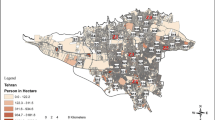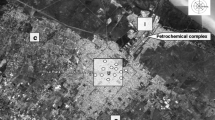Abstract
In the present study, the results of a measurement campaign aiming to assess cancer risk among two special groups of population: policemen and laboratory technicians exposed to the toxic substances, benzene and formaldehyde are presented. The exposure is compared to general population risk. The results show that policemen working outdoor (traffic regulation, patrol on foot or in vehicles, etc.) are exposed at a significantly higher benzene concentration (3–5 times) than the general population, while the exposure to carbonyls is in general lower. The laboratory technicians appear to be highly exposed to formaldehyde while no significant variation of benzene exposure in comparison to the general population is recorded. The assessment revealed that laboratory technicians and policemen run a 20% and 1% higher cancer risk respectively compared to the general population. Indoor working place air quality is more significant in assessing cancer risk in these two categories of professionals, due to the higher Inhalation Unit Risk (IUR) of formaldehyde compared to benzene. Since the origin of the danger to laboratory technicians is clear (use of chemicals necessary for the experiments), in policemen the presence of carbonyls in indoor air concentrations due to smoking or used materials constitute a danger equal to the exposure to traffic originated air pollutants.
Similar content being viewed by others
References
Al-Rehaili, A. M. (2002). Outdoor–indoor air quality in Riyadh: SO2, NH3, AND HCHO. Environmental Monitoring and Assessment, 79, 287–300.
Baez, A., Padilla, H., Garcνa, R., Torres, M. C., Rosas, I., & Belmont, R. (2003). Carbonyls levels in indoor and outdoor air in Mexico City and Xalapa, Mexico. Science of the Total Environment, 302, 211–226.
Baldan, A., Perez Ballesta, P., Cancelinha, J., & De Saeger, E. (1999). Validation of radiello diffusive sampler. Proceedings of the Air Quality in Europe: Challenges for the 2000s, Venezia, 19–21 May 1999.
Ballesta, P. P., Field, A. R., Connolly, R., Cao, N., Caracena, B. A., & Saeger, D. E. (2006). Population exposure to benzene: One day cross-sections in six European cities. Atmospheric Environment, 40, 3355–3366.
Bono, R., Scursatone, E., Schiliro, T., & Gilli, G. (2003). Ambient air levels and occupational exposure to benzene, toluene and xylenes in Northwestern Italy. Journal of Toxicology and Environmental Health, 66, 519–531.
Burnett, R. T., Cakmak, S., Raizenne, M. E., Stieb, D., Vincent, R., Krewski, D., et al. (1998). The association between ambient carbon monoxide levels and daily mortality in Toronto, Canada. Journal of Air and Waste Management Association, 48, 689–700.
Capleton, A. C., & Levy, L. S. (2005). An overview of occupational benzene exposures and occupational exposure limits in Europe and North America. Chemico-Biological Interactions, 153–154, 43–53.
Carletti, R., & Romano, D. (2002). Assessing health risk from benzene pollution in an urban area. Environmental Monitoring and Assessment, 80, 135–148.
Chatzis, C., Alexopoulos, E., & Linos, A. (2005). Indoor and outdoor personal exposure to benzene in Athens, Greece. Science of the Total Environment, 349, 72–80.
Dirks, K. N., Johns, M. D., Hay, J. E., & Sturman, P. A. (2003). A semi-empirical model for predicting the effect of changes in traffic flow patterns on carbon monoxide concentrations. Atmospheric Environment, 37, 2719–2724.
Duarte-Davidson, R., Courage, C., Rushton, L., & Levy, L. (2001). Benzene in the environment: an assessment of the potential risks to the health of the population. Occupational Environmental Medicine, 58, 2–13.
EU-Directive, 2000/69/EC of the European Parliament and of the Council of 16 November 2000 relating to limit values for benzene and carbon monoxide in ambient air. Off. J. Eur. Communities. (OJ L. 163, 29.06.1999), pp. 0041–0021.
Edwards, R. D., Jurvelin, J., Saarela, K., & Jantunen, M. (2001). VOCs concentrations measured in personal samples and residential indoor, outdoor and workplace microenvironments in EXPOLIS—Helsinki, Finland. Atmospheric Environment, 35, 4531–4543.
Elbir, T., Cetin, B., Cetin, E., Bayram, A., & Odabasi, M. (2007). Characterization of volatile organic compounds (VOCs) and their sources in the air of Izmir, Turkey. Environmental Monitoring and Assessment, 133, 149–160.
Ferrari, C. P., Kaluzny, P., & Roche, A. (1998). Aromatic hydrocarbons and aldehydes in the atmosphere of Grenoble, France. Chemosphere, 37, 1587–1601.
Granby, K., Christensen, C. S., & Lohse, C. (1997). Urban and semi-rural observations of carboxylic acids and carbonyls. Atmospheric Environment, 31, 1403–15.
Guerra I, A., Lerda, D., & Martines, C. (1995). Benzene emissions from motor vehicle traffic in the urban area of Milan: Hypothesis of health impact assessment. Atmospheric Environment, 29, 3559–3569.
Hinwood, A. L., Berko, H. N., Farrar, D., Galbally, I. E., & Weeks, I. A. (2006). Volatile organic compounds in selected micro-environments. Chemosphere, 63, 421–429.
Hoek, G., Brunekreef, B., Verhoeff, A., van Wijnen, J., & Fischer, P. (2000). Daily mortality and air pollution in the Netherlands. Journal of Air and Waste Management Association, 50, 1380–1389.
IARC. (1987). IARC monographs on the evaluation of carcinogenic risks to humans. Overall evaluations of carcinogenicity: An updating of IARC Monographs volumes 1 to 42. Suppl 7. Lyons, France: World Health Organization. International Agency for Research on Cancer, 38–74.
IARC (2004). IARC Monographs on the evaluation of carcinogenic risk to humans. International Agency for Research on Cancer.
Jurvelin, J. A., Edwards, R. D., Vartiainen, M., Pasanen, P., & Jantunen, M. J. (2003). Residential indoor, outdoor, and workplace concentrations of carbonyl compounds: relationships with personal exposure concentrations and correlation with sources. Journal of the Air & Waste Management Association, 53(5), 560–573.
Kassomenos, P. A., Karakitsios, S. P., & Pilidis, G. A. (2004). A simple semi-empirical approach to modeling benzene concentrations in a street canyon. Atmospheric Environment, 38, 6073–6078.
Kim, Y. M., Harrad, S., & Harrison, R. M. (2001). Concentrations and sources of VOCs in urban domestic and public microenvironments. Environmental Science and Technology, 35, 997–1004.
Kourtidis, K., Ziomas, I., Zerefos, C., Kosmidis, E., Symeonidis, P., Christophilopoulos, E., et al. (2002). Benzene, toluene, ozone, NO2 and SO2 measurements in an urban street canyon in Thessaloniki, Greece. Atmospheric Environment, 36, 5355–5364.
Leech, J. A., Nelson, W. C., Burnett, R. T., Aaron, S., & Raizanne, M. E. (2002). It’s about time: A comparison of Canadian and American time activity patterns. Journal Exposure Analysis and Environmental Epidemiology, 12(6), 427–432.
Liu, W., Zhang, J., Zhang, L., Turpin, B. J., Weisel, C. P., Morandi, M. T., et al. (2006). Estimating contributions of indoor and outdoor sources to indoor carbonyl concentrations in three urban areas of the United States. Atmospheric Environment, 40, 2202–2214.
Maffei, F., Hrelia, P., Angelini, S., Carbone, F., Forti, G. V., Barbieri, A., et al. (2005). Effects of environmental benzene: Micronucleus frequencies and haematological values in traffic police working in an urban area. Mutation Research, 583, 1–11.
Manini, P., De Palma, G., Andreoli, R., Poli, D., Mozzoni, P., Folesani, G., et al. (2006). Environmental and biological monitoring of benzene exposure in a cohort of Italian taxi drivers. Toxicology Letters, 167, 142–151.
Na, K., Kim, Y. P., Moon, K. C., Moon, I., & Fung, K. (2001). Concentrations of volatile organic compounds in an industrial area of Korea. Atmospheric Environment, 35, 2747–2756.
Ntzaichristos, L., & Samaras, Z. (2000). COPERT 3—Computer Programme to calculate Emissions from Road Transport, Methodology and emission factor (version 2.1). European Environment Agency, Copenhagen.
Petrakis, M., Psiloglou, B., Kassomenos, P., & Cartalis, C. (2003). Summertime measurements of benzene and toluene in Athens using a differential optical absorption spectroscopy system. Journal of Air and Waste Management Association, 53, 1052–1064.
Pilidis, G., Karakitsios, S., & Kassomenos, P. (2005). BTX measurements in a medium sized European city. Atmospheric Environment, 39, 6051–6065.
Tago, H., Kimura, H., Kozawa, K., & Fujie, K. (2005). Formaldehyde concentrations in ambient air in urban and rural areas in Gunma prefecture, Japan. Water, Air, and Soil pollution, 163, 269–280.
U.S. Environmental Protection Agency (1986). Guidelines for carcinogen risk assessment. Fed. Reg. (September 24) 51, 33992–35003.
Author information
Authors and Affiliations
Corresponding author
Rights and permissions
About this article
Cite this article
Pilidis, G.A., Karakitsios, S.P., Kassomenos, P.A. et al. Measurements of benzene and formaldehyde in a medium sized urban environment. Indoor/outdoor health risk implications on special population groups. Environ Monit Assess 150, 285–294 (2009). https://doi.org/10.1007/s10661-008-0230-9
Received:
Accepted:
Published:
Issue Date:
DOI: https://doi.org/10.1007/s10661-008-0230-9




